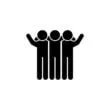Picture this scenario. Your CEO just unveiled an innovative new business strategy and your department is responsible for an important part of it. This requires your team to adopt new processes, skills, and software. You craft a bullet-proof employee training method and dive in.
But your team, which was initially thrilled about the challenge ahead, is faltering.
Only some of your employees are grasping the new information. Others seem totally deflated. Performance is sinking, and now you’re starting to doubt whether your team will be able to produce the type of results your CEO is looking for.
If they can’t perform, the blame is going to fall on your shoulders.
 You might have planned it to a tee, but your employee training method likely doesn’t account for one critical factor: personality differences.
Personality has a huge influence on the way we communicate, work with others, face challenges, and handle conflicts. Failing to consider the different personality types on your team will block your training plan from succeeding.
You might have planned it to a tee, but your employee training method likely doesn’t account for one critical factor: personality differences.
Personality has a huge influence on the way we communicate, work with others, face challenges, and handle conflicts. Failing to consider the different personality types on your team will block your training plan from succeeding.
 Researchers have identified four main personality types.
Though most people possess traits from more than one category, they usually most closely fit in with one group. And while employees who are considered one type may be polar opposites of those from another, their skills usually complement each other’s.
Social psychologists David W. Merrill and Roger H. Reid called the four personality types analytical, driver, amiable, and expressive.
Researchers have identified four main personality types.
Though most people possess traits from more than one category, they usually most closely fit in with one group. And while employees who are considered one type may be polar opposites of those from another, their skills usually complement each other’s.
Social psychologists David W. Merrill and Roger H. Reid called the four personality types analytical, driver, amiable, and expressive.
 Your analytical employees have the self-discipline to get the job done with a high degree of accuracy. But this pursuit of perfection can also slow them down. Analytical people can be negative and critical. They tend to be indecisive since they overanalyze things, which can slow progress.
Your analytical employees have the self-discipline to get the job done with a high degree of accuracy. But this pursuit of perfection can also slow them down. Analytical people can be negative and critical. They tend to be indecisive since they overanalyze things, which can slow progress.
 Drivers are visionaries and tend toward leadership positions. They can see the big picture but often lack the ability to identify the small steps and details required to take them there. They can be harsh sometimes, and often reluctant to admit when they’re wrong.
Drivers are visionaries and tend toward leadership positions. They can see the big picture but often lack the ability to identify the small steps and details required to take them there. They can be harsh sometimes, and often reluctant to admit when they’re wrong.
 One drawback is that sometimes, amiable people’s aversion to conflict prevents them from advocating for themselves. They might stay quiet out of fear they will appear pushy or argumentative.
One drawback is that sometimes, amiable people’s aversion to conflict prevents them from advocating for themselves. They might stay quiet out of fear they will appear pushy or argumentative.
 They are also usually generous, ambitious, and charismatic. They always want to be included in teams, projects, and conversations. But this chattiness can also be a weakness. Sometimes they are too loud, undisciplined, and disorganized.
They are also usually generous, ambitious, and charismatic. They always want to be included in teams, projects, and conversations. But this chattiness can also be a weakness. Sometimes they are too loud, undisciplined, and disorganized.
 When you look at all of the results, think about how each personality type approaches the challenge of learning something new.
For instance, the drivers on your team are probably super excited to execute a new project, but they might lack patience when it comes to learning all of the training material in the interim steps.
Your analytical employees might demonstrate strong engagement during training, but their tendency to get caught up in the details can slow the process down. Learning each of your employees’ personality types will help you prepare for all of these challenges.
When you look at all of the results, think about how each personality type approaches the challenge of learning something new.
For instance, the drivers on your team are probably super excited to execute a new project, but they might lack patience when it comes to learning all of the training material in the interim steps.
Your analytical employees might demonstrate strong engagement during training, but their tendency to get caught up in the details can slow the process down. Learning each of your employees’ personality types will help you prepare for all of these challenges.
 To make your employee training method fit different kinds of personalities, it’s important to incorporate as much flexibility as possible. The most universally effective approach to employee training is a digital solution that enables contextual learning.
Software such as a Digital Adoption Platform (DAP) goes beyond personalization. They are powered by algorithms that analyze context-sensitive factors — such as an employee’s role, user history, and the task at hand — to provide tailored support.
A DAP is built to accommodate any personality type and learner because it responds to specific pieces of information about each user. It also enables employees to maintain high levels of productivity since they can complete unfamiliar tasks as they learn.
To make your employee training method fit different kinds of personalities, it’s important to incorporate as much flexibility as possible. The most universally effective approach to employee training is a digital solution that enables contextual learning.
Software such as a Digital Adoption Platform (DAP) goes beyond personalization. They are powered by algorithms that analyze context-sensitive factors — such as an employee’s role, user history, and the task at hand — to provide tailored support.
A DAP is built to accommodate any personality type and learner because it responds to specific pieces of information about each user. It also enables employees to maintain high levels of productivity since they can complete unfamiliar tasks as they learn.
Discover the employee training solution that works for everyone.
Your employee training method is missing something essential
 You might have planned it to a tee, but your employee training method likely doesn’t account for one critical factor: personality differences.
Personality has a huge influence on the way we communicate, work with others, face challenges, and handle conflicts. Failing to consider the different personality types on your team will block your training plan from succeeding.
You might have planned it to a tee, but your employee training method likely doesn’t account for one critical factor: personality differences.
Personality has a huge influence on the way we communicate, work with others, face challenges, and handle conflicts. Failing to consider the different personality types on your team will block your training plan from succeeding.
Managers must know their employees’ personality types
As a manager, it’s critical to not only be aware of the different personalities on your team, but also understand how to tailor your training and management approach for each person. For example, a tough, blunt approach could energize one employee to complete her goals. But that same approach might make another employee shut down. Team success requires individual success. Just as you have to account for different learning types when building your employee training plan, you must also consider different personality types. You need a versatile approach for motivating and communicating with each team member through training.Understanding the four personality types
 Researchers have identified four main personality types.
Though most people possess traits from more than one category, they usually most closely fit in with one group. And while employees who are considered one type may be polar opposites of those from another, their skills usually complement each other’s.
Social psychologists David W. Merrill and Roger H. Reid called the four personality types analytical, driver, amiable, and expressive.
Researchers have identified four main personality types.
Though most people possess traits from more than one category, they usually most closely fit in with one group. And while employees who are considered one type may be polar opposites of those from another, their skills usually complement each other’s.
Social psychologists David W. Merrill and Roger H. Reid called the four personality types analytical, driver, amiable, and expressive.
Analytical
Analytical people are deep, thoughtful, and serious. They hold themselves to high standards both at work and in their personal lives. They tend to be perfectionists with an eye for detail. They want things done the right way the first time. Your analytical employees have the self-discipline to get the job done with a high degree of accuracy. But this pursuit of perfection can also slow them down. Analytical people can be negative and critical. They tend to be indecisive since they overanalyze things, which can slow progress.
Your analytical employees have the self-discipline to get the job done with a high degree of accuracy. But this pursuit of perfection can also slow them down. Analytical people can be negative and critical. They tend to be indecisive since they overanalyze things, which can slow progress.
Driver
Drivers exude confidence. They are determined, independent, and productive. They move from strategy to execution fast. They’d rather make a bad decision than no decision at all. Drivers are visionaries and tend toward leadership positions. They can see the big picture but often lack the ability to identify the small steps and details required to take them there. They can be harsh sometimes, and often reluctant to admit when they’re wrong.
Drivers are visionaries and tend toward leadership positions. They can see the big picture but often lack the ability to identify the small steps and details required to take them there. They can be harsh sometimes, and often reluctant to admit when they’re wrong.
Amiable
People who fit into the amiable personality type are patient, calm, and balanced. They are usually soft-spoken and sympathetic to others. They don’t partake in gossip and stir conflict. Amiable people are diplomatic and easily look at situations from other people’s perspectives. One drawback is that sometimes, amiable people’s aversion to conflict prevents them from advocating for themselves. They might stay quiet out of fear they will appear pushy or argumentative.
One drawback is that sometimes, amiable people’s aversion to conflict prevents them from advocating for themselves. They might stay quiet out of fear they will appear pushy or argumentative.
Expressive
Expressive people are outgoing, funny, and talkative. They love to have fun and bring humor into work. Expressive personality types are good at keeping the mood light because they hate dullness. They are also usually generous, ambitious, and charismatic. They always want to be included in teams, projects, and conversations. But this chattiness can also be a weakness. Sometimes they are too loud, undisciplined, and disorganized.
They are also usually generous, ambitious, and charismatic. They always want to be included in teams, projects, and conversations. But this chattiness can also be a weakness. Sometimes they are too loud, undisciplined, and disorganized.
How to create an employee training method that fits every personality type
When you understand the way your employees approach their work, what motivates them, how they create and execute goals, and how they approach challenges, you’ll be able to deliver the most effective training. Here are six steps for creating a training method that accounts for different personality types.1. Start with a personality assessment
Verified personality quizzes are a reliable way to dig into what personality types exist on your team. Some examples include the Myers-Briggs Type Indicator, CliftonStrengths, and the Riso-Hudson Enneagram Type Indicator. These tests are created by experts in psychology and organizational studies. The in-depth assessments not only tell your employees what their personality types are, they explain what they mean. Employees gain an understanding of how certain personality traits affect their work styles and attitudes. It helps them figure out what types of projects and settings they will perform best in, and what types of emotional reactions they might experience in certain situations.2. Think about the challenges each personality type will face during training
 When you look at all of the results, think about how each personality type approaches the challenge of learning something new.
For instance, the drivers on your team are probably super excited to execute a new project, but they might lack patience when it comes to learning all of the training material in the interim steps.
Your analytical employees might demonstrate strong engagement during training, but their tendency to get caught up in the details can slow the process down. Learning each of your employees’ personality types will help you prepare for all of these challenges.
When you look at all of the results, think about how each personality type approaches the challenge of learning something new.
For instance, the drivers on your team are probably super excited to execute a new project, but they might lack patience when it comes to learning all of the training material in the interim steps.
Your analytical employees might demonstrate strong engagement during training, but their tendency to get caught up in the details can slow the process down. Learning each of your employees’ personality types will help you prepare for all of these challenges.
3. Share the personality test results with the team
Collaboration is fundamental to team success. It often plays a key role in training, especially when you’re gearing up for a big team project. The best way to get all of your employees to work together is for them to understand one another better. By sharing the results of everyone’s personality tests, everyone will know how each other works, and therefore be able to work together more effectively. They will approach projects, communication, and conflict with greater empathy.4. Ask your employees how they like to learn
You’re already making an effort to tailor your employee training method to the different personalities on your team. Why not eliminate the guesswork and ask them how they like to learn? Ask your employees:- What aspects of training were challenging to you in the past?
- Which aspects did you like?
- What tools and resources did you wish you had?
- Do you prefer a self-paced training method or an instructor-led approach?
- How much time do you expect it will take to learn X, Y, Z?
5. Identify your training “musts”
When it’s time to create your training plan, first clearly define the desired outcome. What are your main goals? What are the most important parts to cover? Who needs to be involved? How can you fit training into employee workflow? Once you answer these questions, you can decide the best employee training method to choose. To make your employee training method fit different kinds of personalities, it’s important to incorporate as much flexibility as possible. The most universally effective approach to employee training is a digital solution that enables contextual learning.
Software such as a Digital Adoption Platform (DAP) goes beyond personalization. They are powered by algorithms that analyze context-sensitive factors — such as an employee’s role, user history, and the task at hand — to provide tailored support.
A DAP is built to accommodate any personality type and learner because it responds to specific pieces of information about each user. It also enables employees to maintain high levels of productivity since they can complete unfamiliar tasks as they learn.
To make your employee training method fit different kinds of personalities, it’s important to incorporate as much flexibility as possible. The most universally effective approach to employee training is a digital solution that enables contextual learning.
Software such as a Digital Adoption Platform (DAP) goes beyond personalization. They are powered by algorithms that analyze context-sensitive factors — such as an employee’s role, user history, and the task at hand — to provide tailored support.
A DAP is built to accommodate any personality type and learner because it responds to specific pieces of information about each user. It also enables employees to maintain high levels of productivity since they can complete unfamiliar tasks as they learn.

